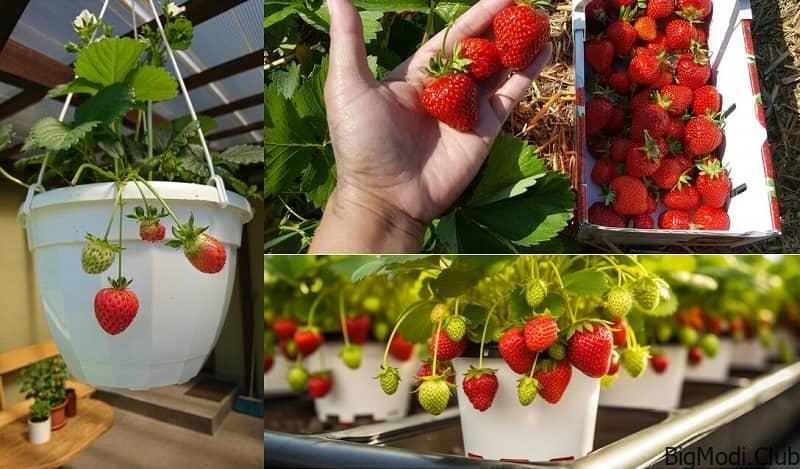Growing strawberries can be one of the most rewarding gardening experiences, offering fresh, sweet fruits right from your garden. Whether you’re a seasoned gardener or a beginner, learning how to grow strawberries will set you on the path to enjoying these delicious berries all season long. This guide will take you through everything you need to know about how to grow strawberries, from choosing the right varieties and planting techniques to ensuring the best growing conditions for a bountiful harvest.
How to Grow Strawberry: A Comprehensive Guide
Varieties of Strawberries
- Summer-Fruiting/June-Bearing Varieties: These varieties yield a single, concentrated harvest over a few weeks in early summer, making them ideal for those who want a large batch of strawberries at once.
- Ever-Bearing/Perpetual Varieties: These provide two smaller harvests—one in early summer and another toward the end of summer—giving you fresh strawberries throughout the growing season.
- Day Neutral Strawberries: These varieties produce fruit sporadically throughout the growing season, offering a steady supply of strawberries.
Best Growing Conditions
- Sunlight: For the sweetest strawberries, ensure they grow in full sunshine.
- Soil: Choose a sunny, sheltered site with fertile, well-draining soil, preferably slightly acidic. Before planting, enrich the soil with organic matter, such as compost or well-rotted manure.
- Avoid Frost-Prone Areas: Protect early flowering varieties by planting them in areas less likely to experience late frosts.
Planting Techniques
- Spacing: Place strawberry plants about 20 inches (50 cm) apart to give them room to grow.
- Planting Depth: Ensure the crown of the plant (where the leaves emerge) is at soil level.
- Bare-Root Plants: Before planting, soak bare-root plants in water for an hour, trim any long roots, and plant them at the correct depth.
Container Growing
- Suitable Containers: Strawberries thrive in containers, tubs, towers, or hanging baskets.
- Soil: Use an all-purpose potting mix and ensure the container has drainage holes.
- Spacing: In containers, plants can be spaced closer together but may need to be divided and replanted after one season.
Watering and Fertilizing
- Regular Watering: This is crucial, especially as the plants establish and during dry spells. Container-grown strawberries are particularly vulnerable to drying out.
- Fertilizing: Before spring growth, enrich the soil with a general-purpose organic fertilizer. During flowering, feed container strawberries weekly with a potassium-rich liquid fertilizer to support fruit development.
Mulching and Care
- Mulch: Apply a mulch of straw around the plants from early summer to keep fruits clean, reduce weed growth, and retain moisture.
- Runners: In the first year, remove runners to help the plant focus on fruit production. In subsequent years, these runners can be used to propagate new plants.
Protecting the Harvest
- Birds: Use netting to keep birds away from your strawberries, but ensure that pollinators can still access the plants.
- Frost Protection: During frost-prone periods, cover the plants with row covers or garden fleece, removing them during the day to allow pollinators to do their work.
- Slugs: To protect against slugs, consider using slug traps or growing strawberries in containers.
Harvesting and Post-Harvest Care
- When to Pick: Harvest strawberries when they are fully ripe, preferably on a sunny afternoon, for the best flavor.
- Storage: While refrigeration may reduce flavor, it’s best to store strawberries in the refrigerator. However, if possible, keep them at a cool room temperature to preserve their taste.
- End-of-Season Care: Clean up the strawberry plants by removing old straw, weeding, and cutting back old foliage, leaving only the fresh growth in the center.
Plant Longevity
- Plant Replacement: After about three seasons, it’s a good idea to replace your strawberry plants. Be sure to plant the new ones in fresh soil, preferably in a different part of the garden.
How Long Do Strawberries Take to Grow?
On average, strawberries take about three months to grow and produce fruit. This period includes the entire process, from planting to harvest. Depending on the variety, strawberries usually start fruiting from early summer and can continue until the first fall frosts. They grow faster than melon-type fruits, such as cantaloupe, making them a popular choice for gardeners seeking a quicker yield.
How to Grow Strawberries from Seeds
Seed Type and Plant Characteristics
- Alpine Strawberries: When starting strawberries from seed, they are often alpine varieties or close relatives. These plants typically produce smaller berries, about an inch long, with an intense fragrance. While they yield fewer berries per plant, these strawberries are perfect for fresh eating.
Seed Starting Process
- Indoor Start: Begin sowing the seeds indoors about 8 weeks before the last frost. Use a shallow container filled with a fine seed-starting mix.
- Sowing Seeds: Sprinkle the seeds on top of the mix and lightly cover them with soil. Strawberry seeds need light to germinate, so don’t bury them deeply. Mist the soil daily to keep it moist.
- Lighting and Temperature: Position a grow light or shop light about 6 inches above the container. Maintain a temperature between 65 to 70℉ for the best germination results.
Germination
- Time Frame: Strawberry seeds can take anywhere from 14 to 45 days to germinate.
- Care During Germination: Keep misting the soil to maintain moisture, and provide ample light. Make sure the soil does not dry out during this period.
Preparing Seedlings for Outdoor Planting
- Acclimation: Once the seedlings have multiple sets of leaves and are at least 3 inches tall, gradually acclimate them to outdoor conditions by placing them outside for a few hours each day for about a week before planting them in the garden.
Planting
- Location: Alpine strawberries do well in landscape beds or containers and are excellent as low-growing edging plants.
- Sunlight: Ensure the plants receive at least 6 hours of bright sunlight daily for optimal flowering and fruiting.
- Spacing: These strawberries grow in clumps about 6 to 8 inches across and do not produce runners, so space the plants about 8 inches apart.
Watering
- Moisture Requirements: Consistent moisture is key to good berry production. Aim for about 1 inch of water per week. Check the soil moisture before watering, especially in areas with clay soil, as it retains moisture longer.
When to Plant Strawberry Seeds
Timing for Planting Strawberry Seeds
- Early Spring: Sow strawberry seeds in early spring in a container with soil mixed with universal compost. Cover the seeds with a thin layer of soil and water gently.
- Germination Conditions: Ensure a temperature of about 65-70°F (18-21˚C) for successful germination.
- Planting for Harvest: To harvest berries from late May to early July, plant your seedlings in April.
Pre-Planting Preparation
- Freezing Seeds: Before planting, freeze the seeds in December or January. Use a ziplock bag or sealed envelope for freezing.
- Defrosting Seeds: Remove the seeds from the freezer in February and let them defrost at room temperature for a day or two before planting.
Planting Seeds
- Depth of Planting: When planting seeds in pots, place them about 1/2 inch (1.5 cm) deep in soil mixed with multipurpose compost.
- Light Requirement: As strawberries need light to germinate, keep the container in a sunny room.
FAQs
Can you grow strawberries from fresh strawberry seeds?
Yes, you can grow strawberries from fresh strawberry seeds, but it requires some preparation. After extracting the seeds from a fresh strawberry, you should clean and dry them before planting. It’s also beneficial to freeze the seeds for a few weeks before planting to simulate winter conditions, which can improve germination rates. However, keep in mind that strawberries grown from fresh seeds might not produce fruit identical to the parent plant, especially if the original strawberry was a hybrid variety.
Are strawberries the only fruit with seeds on the outside?
Yes, strawberries are unique in that they have their seeds on the outside. Unlike most fruits, where seeds are contained within, the tiny seeds dotting the surface of a strawberry are actually the fruit’s true seeds, called “achenes.” Each achene is a small, individual fruit, with the fleshy part we commonly eat being an enlarged part of the flower called the “receptacle.”
How to germinate strawberry seeds quickly?
To germinate strawberry seeds quickly, start by freezing the seeds for 2-4 weeks to simulate winter. After freezing, plant the seeds in a shallow container filled with fine seed-starting mix. Lightly cover the seeds with soil, as they need light to germinate, and maintain a warm environment with temperatures between 65-70℉. Mist the soil regularly to keep it moist. Using a grow light or placing the container in a sunny spot will help speed up the germination process, which can take anywhere from 14 to 45 days.
Where do strawberries grow best?
Strawberries grow best in full sunlight and well-drained, fertile soil that is slightly acidic. They thrive in environments with plenty of sunshine, ideally at least 6 hours of direct light daily. A sheltered spot that protects them from strong winds and frost is ideal. Additionally, enriching the soil with organic matter, like compost or well-rotted manure, will promote healthy growth and bountiful fruit production. Whether in garden beds or containers, strawberries prefer temperate climates with moderate temperatures, avoiding extreme heat or frost.


